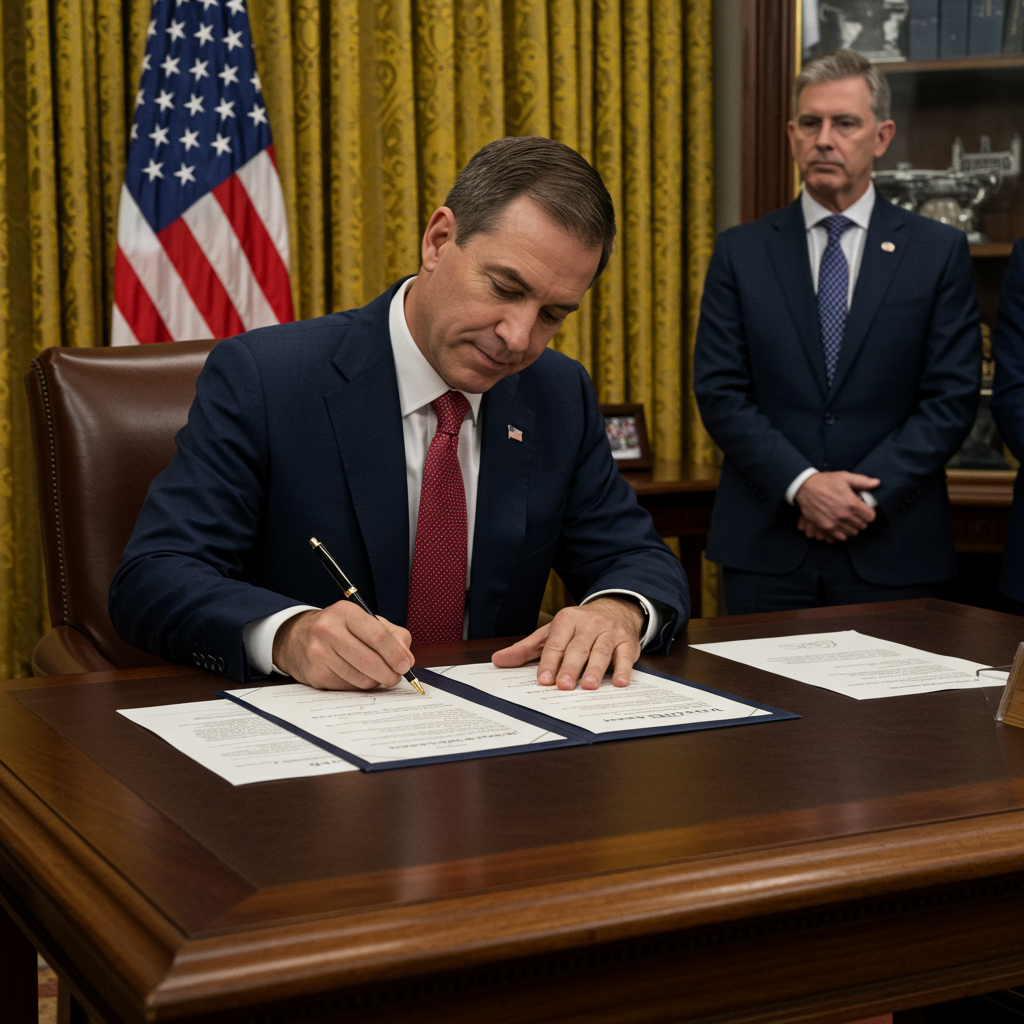A sweeping legislative package, frequently dubbed “The One, Big, Beautiful Bill,” has successfully cleared Congress and is now headed to the President’s desk for signature. This extensive measure, described by proponents as the largest tax cut in American history, passed the House of Representatives by a narrow 218-214 vote. Its passage followed intense debate and effort to secure the necessary votes, occurring just ahead of a key deadline. The bill had previously secured a narrow 51-50 victory in the Senate, requiring the Vice President to cast the tie-breaking vote.
This significant legislation represents a broad collection of policy priorities encompassing not only substantial changes to the tax code but also major shifts in government spending and national security policy. It marks a pivotal moment in federal governance, drawing strong reactions across the political spectrum regarding its projected impacts on the economy, individuals, and the national debt.
Unpacking the Tax Provisions
Central to the bill are numerous changes impacting taxes for individuals and businesses. A primary goal stated by its supporters is to prevent a large tax increase that would occur as provisions from earlier legislation expire. The bill aims to achieve this by making permanent the tax rates and brackets established in 2017.
Key tax benefits touted include putting more money directly into the pockets of Americans:
The typical family could see up to $10,900 in additional take-home pay.
Workers may experience increased wages up to $7,200.
Households earning below $100,000 are projected to receive a 12 percent tax cut compared to current levels.
Specific tax relief measures are also highlighted:
No tax on tips for service workers.
Elimination of tax on overtime pay.
No tax on interest from car loans.
Significant tax relief measures for seniors.
A $6,000 deduction specifically for older adults earning up to $75,000 annually, framed as a step toward potentially eliminating taxes on Social Security benefits.
The legislation substantially impacts family and education finances. It locks in and boosts the doubled Child Tax credit, increasing it to $2,200 for millions of American families. The doubled Standard Deduction is also made permanent and further increased to $31,500 for families, simplifying tax filing for many. Educational opportunities are addressed by expanding access to 529 education savings accounts, allowing funds to be used for K-12 materials and trades credentials.
Furthermore, the bill supports working families and businesses through various credits. It expands access to the child care credit, makes the paid leave tax credit permanent, enhances the Adoption tax credit, and grows the child and dependent care credit and Flexible Spending Accounts (FSAs). For high-tax states, a key provision increases the cap on the State and Local Tax (SALT) deduction to $40,000 for five years. Business-related changes include allowing companies to immediately write off the full cost of equipment and research investments.
Major Spending Shifts and Cuts
Beyond tax adjustments, the bill outlines significant spending reallocations. It includes a substantial investment in border security, totaling over $175 billion. This funding targets measures such as completing border barriers, establishing detention facility beds, hiring thousands of new Immigration and Customs Enforcement (ICE) officers and Border Patrol agents, and implementing new fees for immigrants seeking asylum. The stated aim is to significantly increase deportations, particularly targeting criminal illegal immigrants in sanctuary cities. The Department of Defense also receives billions for shipbuilding, munitions, and quality-of-life improvements, including funding allocated from the defense budget towards border security efforts.
Conversely, the legislation includes considerable cuts to mandatory spending programs. These cuts disproportionately affect social safety net programs like Medicaid and the Supplemental Nutrition Assistance Program (SNAP). Proponents argue these changes address “waste, fraud, and abuse” and aim to “rightsize” the programs.
However, critics and nonpartisan analyses highlight the potential impact on beneficiaries:
The Congressional Budget Office (CBO) projects approximately $1 trillion in Medicaid spending cuts over a decade.
These cuts could result in nearly 12 million Americans losing health coverage by 2034.
The bill introduces new requirements, including mandatory work hours (80 hours per month) for many adult Medicaid and SNAP recipients, extending to older adults up to age 65 and parents of children aged 14 and older.
CBO estimates suggest around 3 million people could lose SNAP benefits.
A potential new $35 co-payment for Medicaid services is also included.
Some SNAP costs will shift to states starting in 2028, dependent on payment error rates.
Democrats largely opposed the bill, citing concerns about cuts to essential services and arguing it shifts wealth towards the wealthiest individuals and corporations at the expense of vulnerable populations. They described the measure as “immoral” and harmful to seniors, children, and individuals with disabilities.
Additional Provisions and Fiscal Debate
The comprehensive nature of the bill extends to numerous other policy areas. It includes provisions rolling back tax breaks for clean energy initiatives, such as allowing the electric vehicle tax credit to expire earlier than planned. Conversely, it expands tax credits for critical material production, including metallurgical coal.
Other notable additions include:
Creating “Trump Accounts,” a children’s savings program potentially initiated with a Treasury deposit.
Allocating $40 million for a “National Garden of American Heroes.”
Implementing new excise taxes on university endowments and remittances sent abroad.
Eliminating federal taxes on gun silencers and certain short-barreled firearms.
Barring Medicaid payments for one year to family planning providers offering abortions.
Expanding compensation under the Radiation Exposure Compensation Act.
Providing billions for space exploration programs like Artemis and Mars missions.
Increasing the national debt limit by $5 trillion.
- Including a last-minute addition providing $10 billion annually for rural hospitals for five years.
- stefanik.house.gov
- www.npr.org
- www.desmoinesregister.com
- abc7.com
- www.democratandchronicle.com
The overall fiscal impact of the bill is a point of significant contention. While the CBO projects the legislation could increase federal deficits by $3.3 to $3.4 trillion over the next decade, proponents sometimes use an alternative calculation baseline that treats existing tax breaks as permanent, arguing under this approach the bill would actually reduce deficits. Critics dismiss this alternative method as an “accounting gimmick.” The nonpartisan Committee for a Responsible Federal Budget has also raised concerns about the bill’s impact on the deficit.
The passage of this bill reflects a deep partisan divide over the direction of federal policy. Supporters emphasize the tax relief for individuals and businesses, investments in national security, and efforts to reduce spending and perceived fraud. Opponents focus on the cuts to social safety nets, the projected increase in the national debt, and the disproportionate benefits seen by higher-income households according to nonpartisan analyses. As the bill awaits presidential signature, its implementation is expected to bring about significant and widely debated changes across numerous aspects of American life and the federal government’s role.
Frequently Asked Questions
What are the main components of this new tax and spending bill?
This comprehensive legislation includes significant changes across several areas. It features substantial tax cuts, making permanent existing rates and adding temporary new deductions for things like tips and overtime. It also includes major new spending on border security and national defense. To offset some costs, it proposes significant cuts to mandatory spending programs such as Medicaid and SNAP. The bill also contains a wide array of other specific policy provisions.
How is the bill projected to impact different groups of Americans?
Proponents argue the bill will benefit families, workers, and small businesses through increased take-home pay, higher wages, and job creation. Specific groups like seniors, parents receiving the Child Tax Credit, and those benefiting from increased Standard Deductions are highlighted. However, nonpartisan analyses project that while the wealthiest households may see significant financial gains, the poorest individuals could face costs, primarily due to accompanying reductions in health coverage and food assistance from cuts to Medicaid and SNAP.
What happens next after the House passes the bill?
After passing the House of Representatives, the bill is sent to the President of the United States for his signature. If the President signs the bill, it then becomes law, and the relevant government agencies will begin implementing its provisions. This includes changes to tax codes, adjustments to benefit programs, activation of funding for border security measures, and implementation of all other policies contained within the extensive legislation.
Word Count Check: 1111



